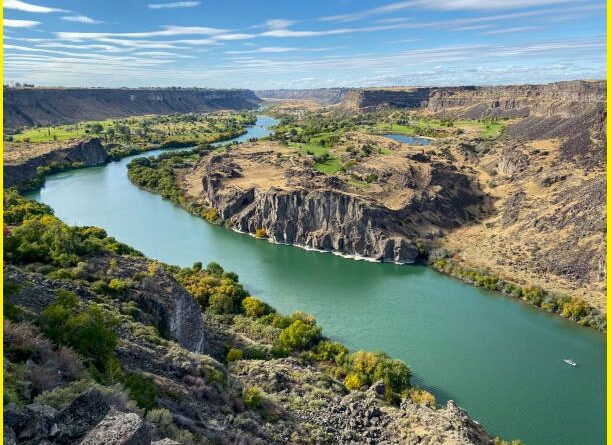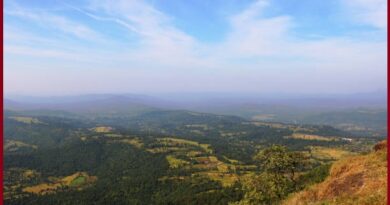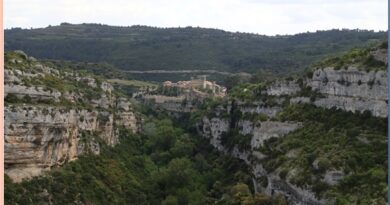Serpentine Splendor- Adventures Along ‘Snake River Canyon’
Snake River Canyon
Snake River Canyon is a canyon formed by the Snake River in the Magic Valley region of southern Idaho, forming part of the boundary between Twin Falls County and Jerome County. The canyon ranges up to 150 meters deep and 0.40 kilometers wide and runs for just over 50 miles. The Snake River Canyon is a significant geographic feature creating a dramatic landscape primarily in Idaho and Oregon. The canyon was carved out over millions of years, primarily through erosion and volcanic activity. It is characterized by its cliffs, rugged terrain, and the winding path of the Snake River flowing through it.
The Canyon features many geological structures like Twin waterfalls and Shoshone waterfalls. The Snake River Canyon Idaho is a popular destination for outdoor enthusiasts, offering opportunities for activities such as hiking, camping, fishing, and whitewater rafting. The canyon’s scenic beauty and rugged terrain continue to attract visitors from around the world.
One of the most famous events associated with the River Canyon is Evel Knievel’s attempted jump across it in 1974. Knievel, a daredevil and stunt performer, attempted to jump the canyon in a specially designed rocket-powered motorcycle called the Skycycle X-2.
Evel Knievel Snake River Canyon
Evel Knievel’s attempt to jump across the Snake River Canyon Idaho in 1974 remains one of the most iconic moments in the history of daredevil stunts and extreme sports. Knievel, born Robert Craig Knievel, was a renowned American stunt performer known for his motorcycle jumps over various obstacles and his flamboyant personality.
The attempt to jump the Snake River Canyon was one of Knievel’s most ambitious and highly publicized stunts. He planned to use a specially designed rocket-powered motorcycle called the “Skycycle X-2” to clear the canyon. The rocket was built by engineer Robert Truax and resembled a streamlined missile with a cockpit for Knievel.

On September 8, 1974, thousands of spectators gathered near the canyon to witness the event. However, the jump did not go as planned. The parachute deployed prematurely shortly after takeoff, causing the Skycycle to drift back into the canyon. Knievel landed safely on the canyon floor, escaping with only minor injuries.
Also, Read- 8 Best Natural Hot Springs in the USA
Despite the failed jump, Evel Knievel’s attempt at the River Canyon captured the imagination of the public and solidified his status as a legendary figure in the world of stunt performance. The event has since become an iconic moment in the history of extreme sports and daredevilry.
Snake River Canyon Rim Trail
The Snake River Canyon Rim Trail is a popular recreational trail that follows the scenic rim of the Snake River Canyon, offering stunning views of the canyon and surrounding landscape. The trail is located primarily in Twin Falls, Idaho, and provides opportunities for hiking, jogging, biking, and wildlife observation.
The trail offers breathtaking panoramic views of the Snake River Canyon, which cuts through the rugged landscape of southern Idaho. Visitors can enjoy vistas of the canyon, the Snake River below, and the surrounding geological formations. v
Accessibility- The trail is accessible to a wide range of outdoor enthusiasts, including hikers, joggers, cyclists, and families. It features well-maintained pathways and is suitable for various skill levels.
Length and Sections- The Snake River Canyon Rim Trail spans several miles along the canyon rim, with multiple access points and trailheads along the route. While the entire trail is extensive, visitors can choose to explore specific sections based on their preferences and available time.
Snake River Canyon Rafting
Snake River Canyon Idaho rafting offers adventurers a thrilling and scenic experience in the rugged landscapes of the western United States. The Snake River, which originates in Wyoming and flows through Idaho, Oregon, and Washington, provides opportunities for a variety of rafting experiences, including calm floats and challenging whitewater rapids.
Whitewater Rafting- The Snake River features sections with varying degrees of whitewater rapids, offering rafters opportunities for exciting and adrenaline-pumping experiences. The degree of difficulty varies depending on the section of the river and the time of year, with spring and early summer typically providing higher water levels and more challenging rapids. Rafting through the River Canyon offers breathtaking views of the surrounding landscapes, including towering cliffs, rugged canyons, and diverse wildlife habitats. The canyon’s dramatic scenery enhances the adventure and provides a memorable backdrop for rafting trips.
Guided Tours- Many outfitters and guide companies offer guided rafting tours on the Snake River, providing both experienced and novice rafters with the opportunity to safely navigate the river’s waters. These guided tours often include expert guides who are familiar with the river’s currents, hazards, and points of interest.
Snake River Canyon Twin Waterfalls
The Twin Falls in the Snake River Canyon are a spectacular natural feature and a prominent attraction in the area, drawing visitors from around the region to witness their beauty and power. The river flows over basalt cliffs, creating two separate waterfalls that cascade down into the canyon below.
The Twin waterfalls consist of two main drops. The upper waterfalls have a height of approximately 125 feet, while the lower falls measure around 150 feet in height. Together, they create a stunning display of water cascading down the cliffs. Visitors can access viewpoints and observation areas near the falls to admire them from various vantage points. There are pathways and trails in the area that provide opportunities for hiking and exploring the canyon.
The Twin Falls are surrounded by the dramatic scenery of the River Canyon, characterized by towering cliffs, rocky outcrops, and the rushing waters of the river. The falls and the surrounding landscape offer breathtaking photo opportunities and opportunities for outdoor recreation.

How to reach Snake River Canyon
Reaching the Snake River Canyon depends on your starting point and the specific area of the canyon you wish to visit, as it spans across multiple states and regions. However, if you’re aiming to visit popular locations such as Twin Falls, Idaho, where the River Canyon is particularly scenic.
By Car
If you’re traveling from distant locations, you may consider driving. Interstate 84 passes through Twin Falls, Idaho, providing convenient access to the area. From Boise, Idaho, you can take I-84 East, which is approximately a 2-hour drive to Twin Falls. From Salt Lake City, Utah, you can take I-84 West, which is approximately a 4-hour drive to Twin Falls.
The closest airport to Twin Waterfalls is the Magic Valley Regional Airport, which offers limited commercial flights. Alternatively, travelers can fly into Boise Airport or Salt Lake City International Airport and then rent a car for the drive to Twin Waterfalls.
Public transportation options to Twin Waterfalls are limited. There is no direct train or bus service to the area, so most visitors rely on personal vehicles or rental cars. Once you arrive at Twin Waterfalls, you can easily access viewpoints, trails, and other attractions within the River Canyon area by car or on foot. Be sure to check local maps and guides for specific directions to your desired destinations within the canyon.



